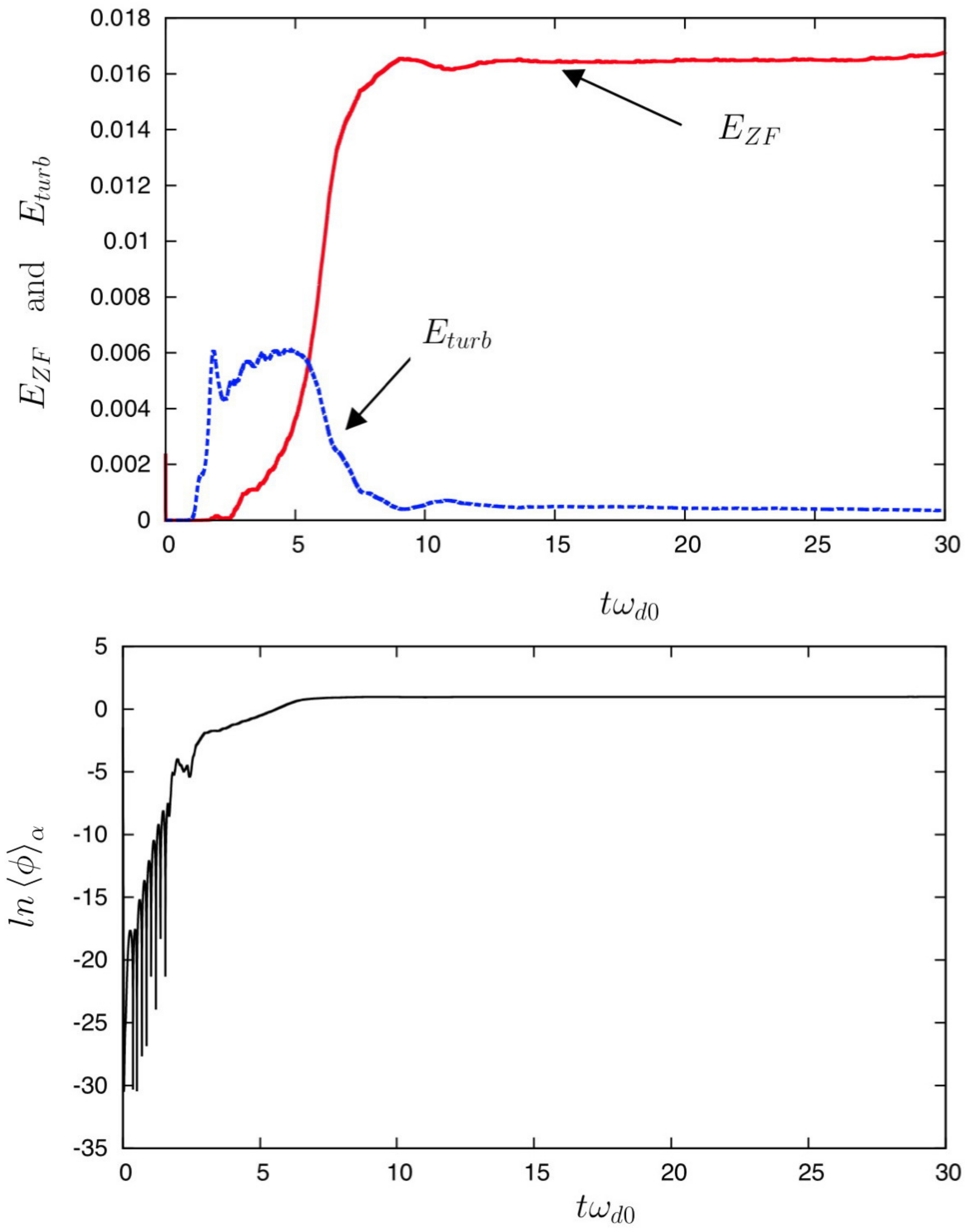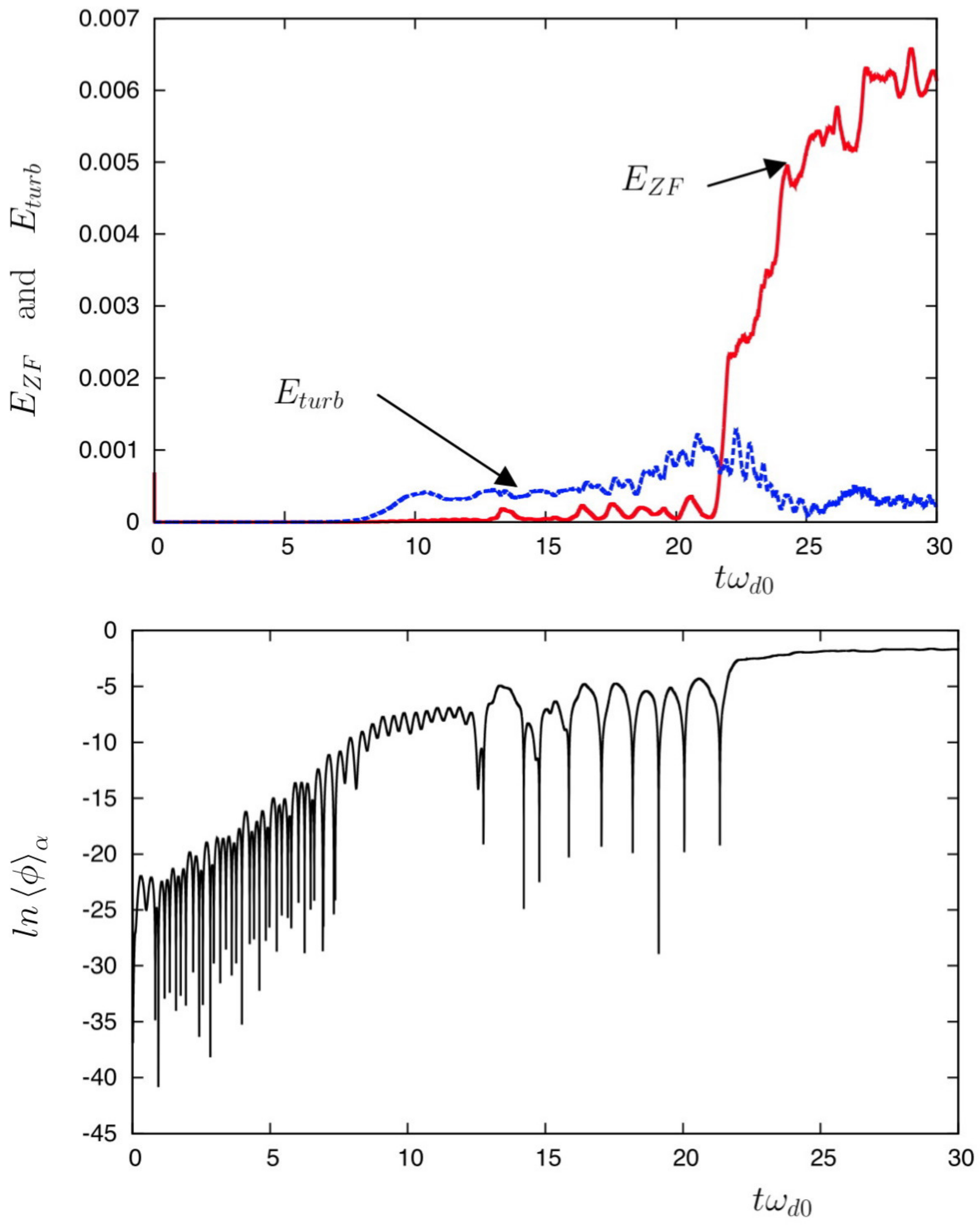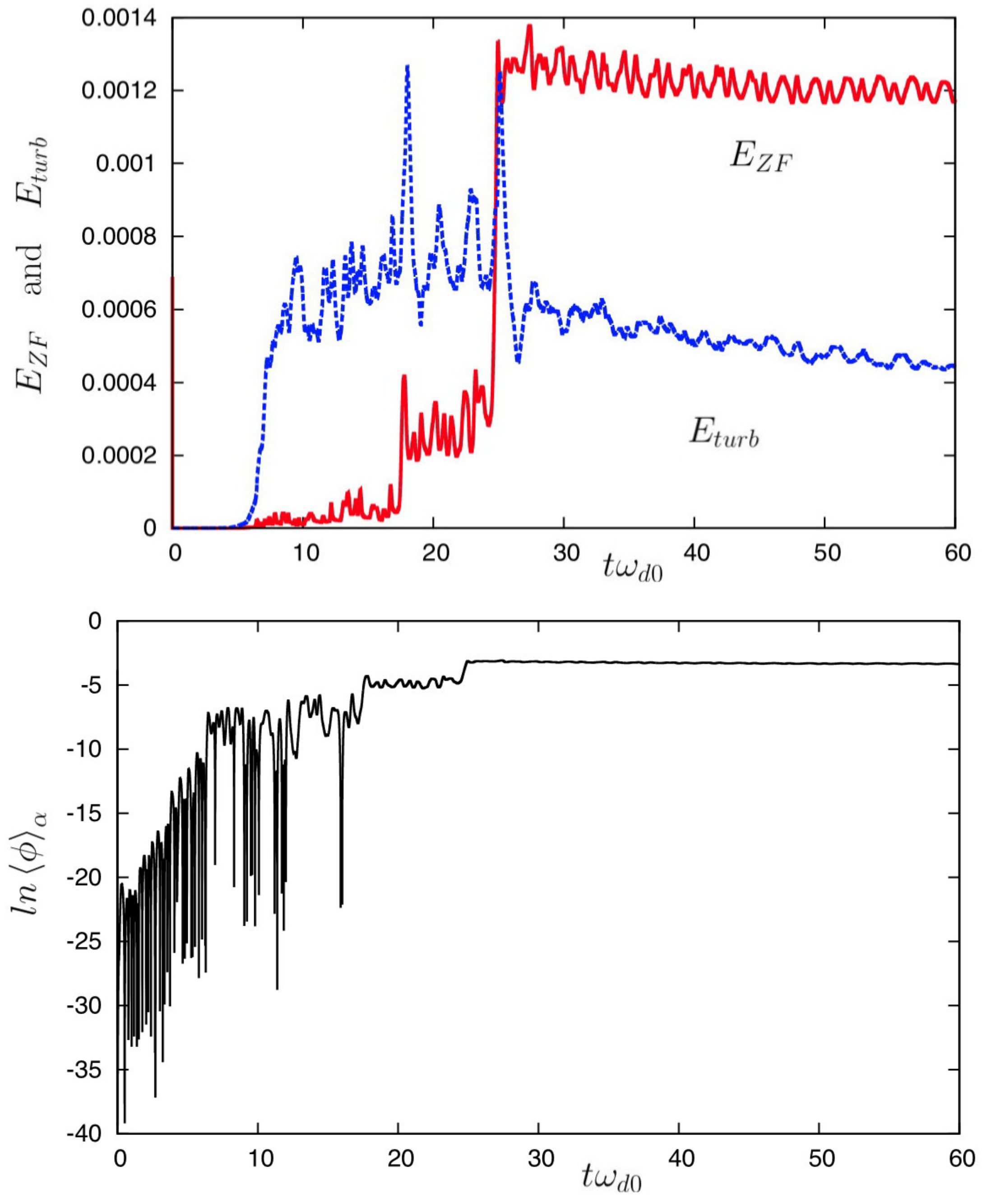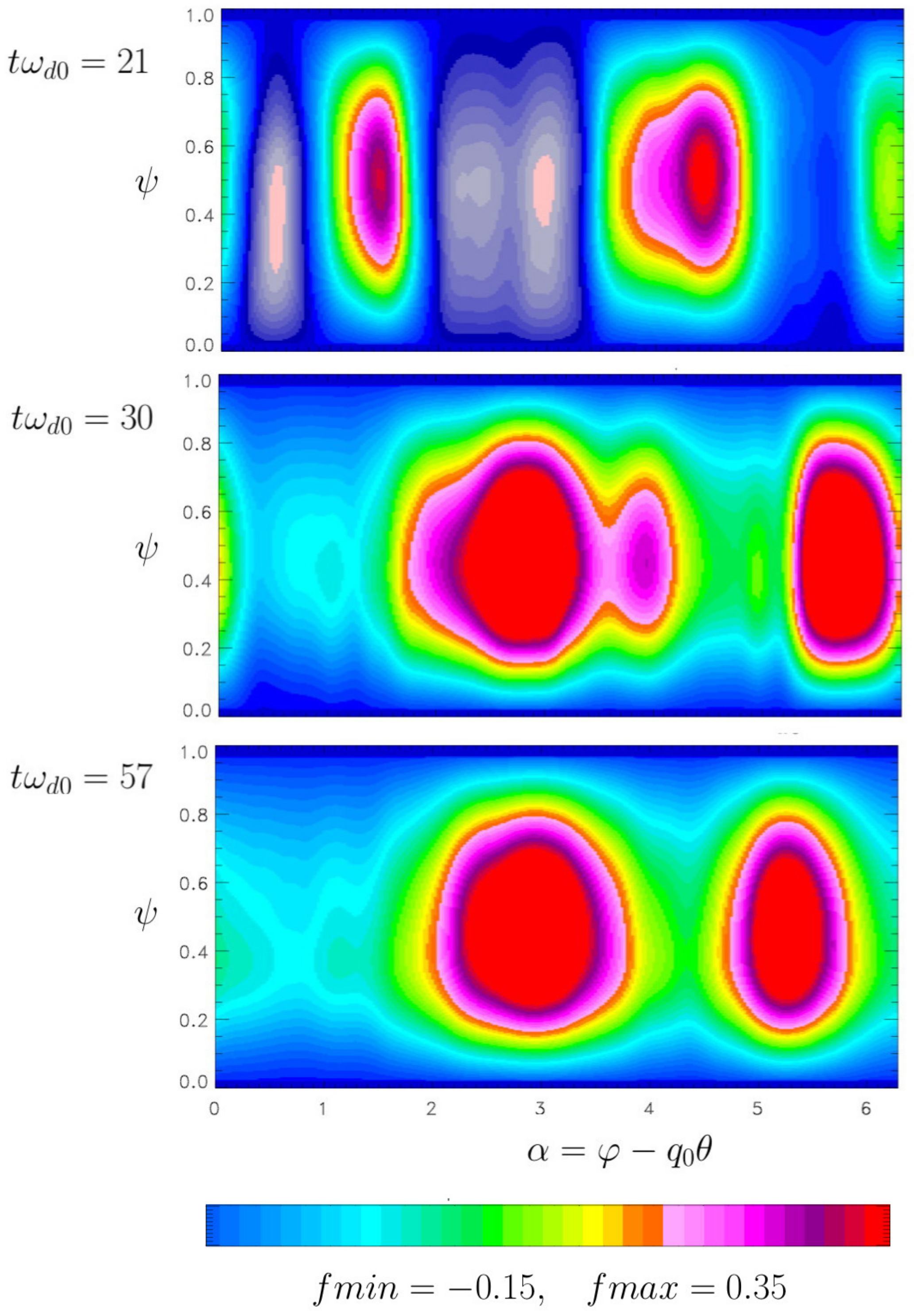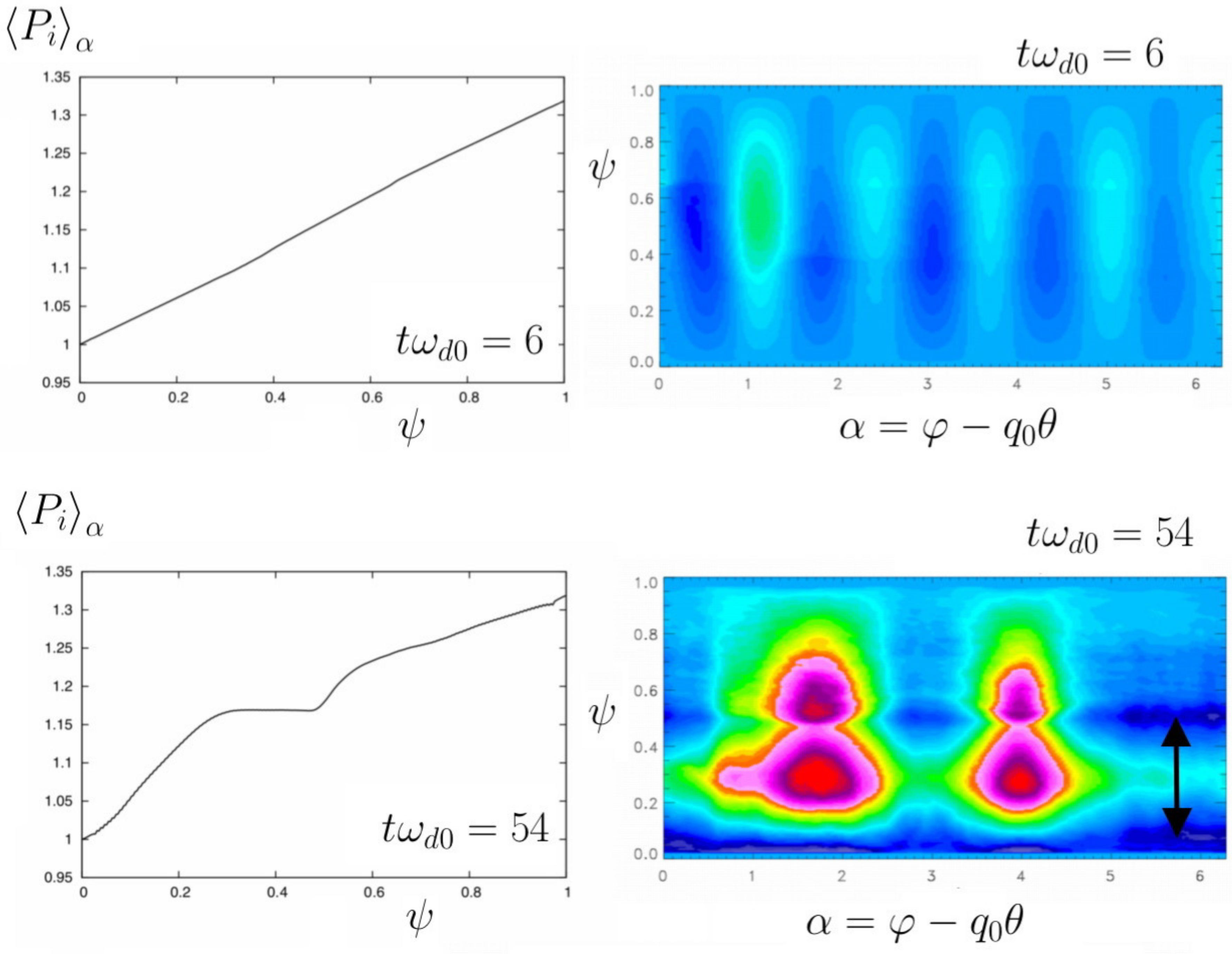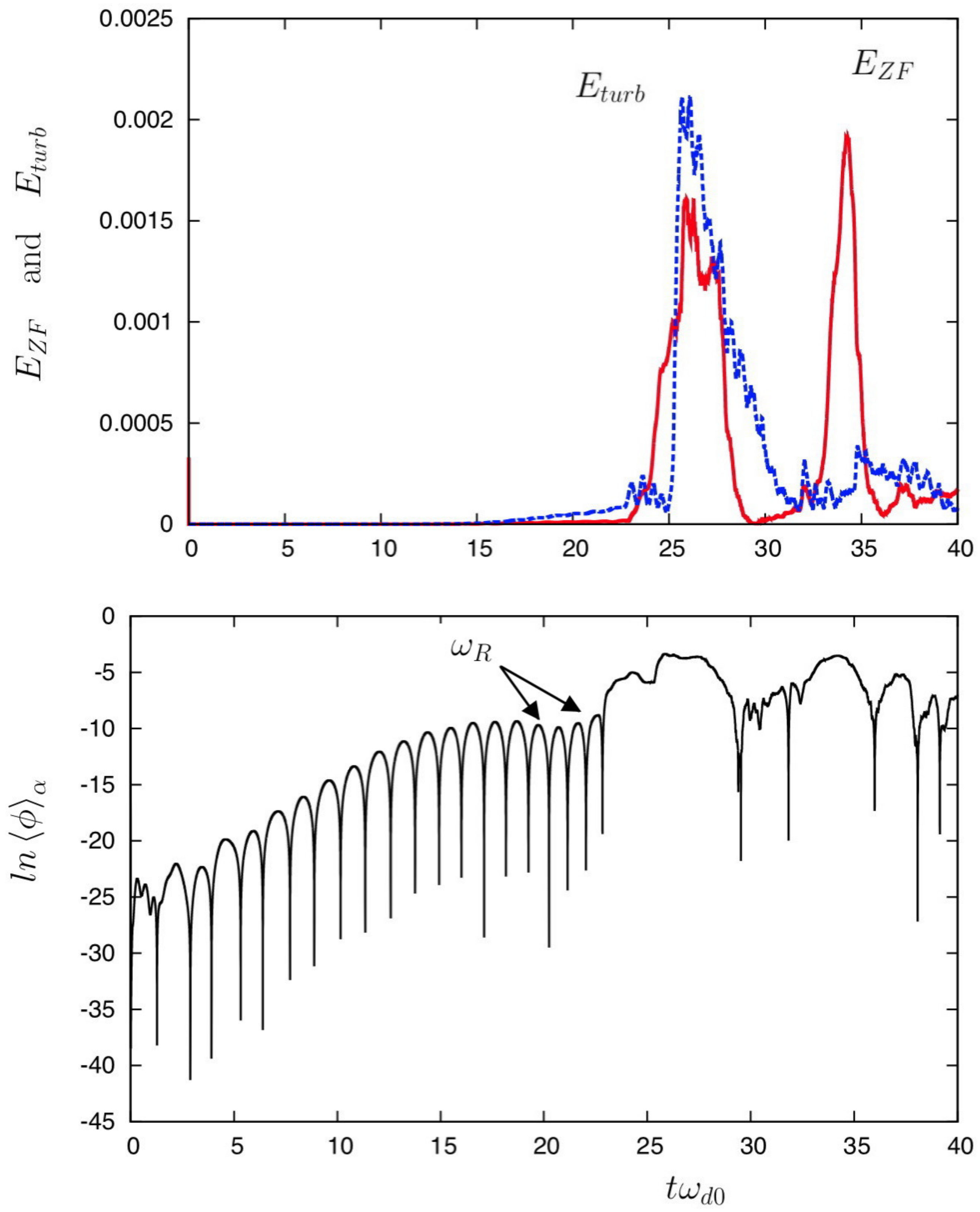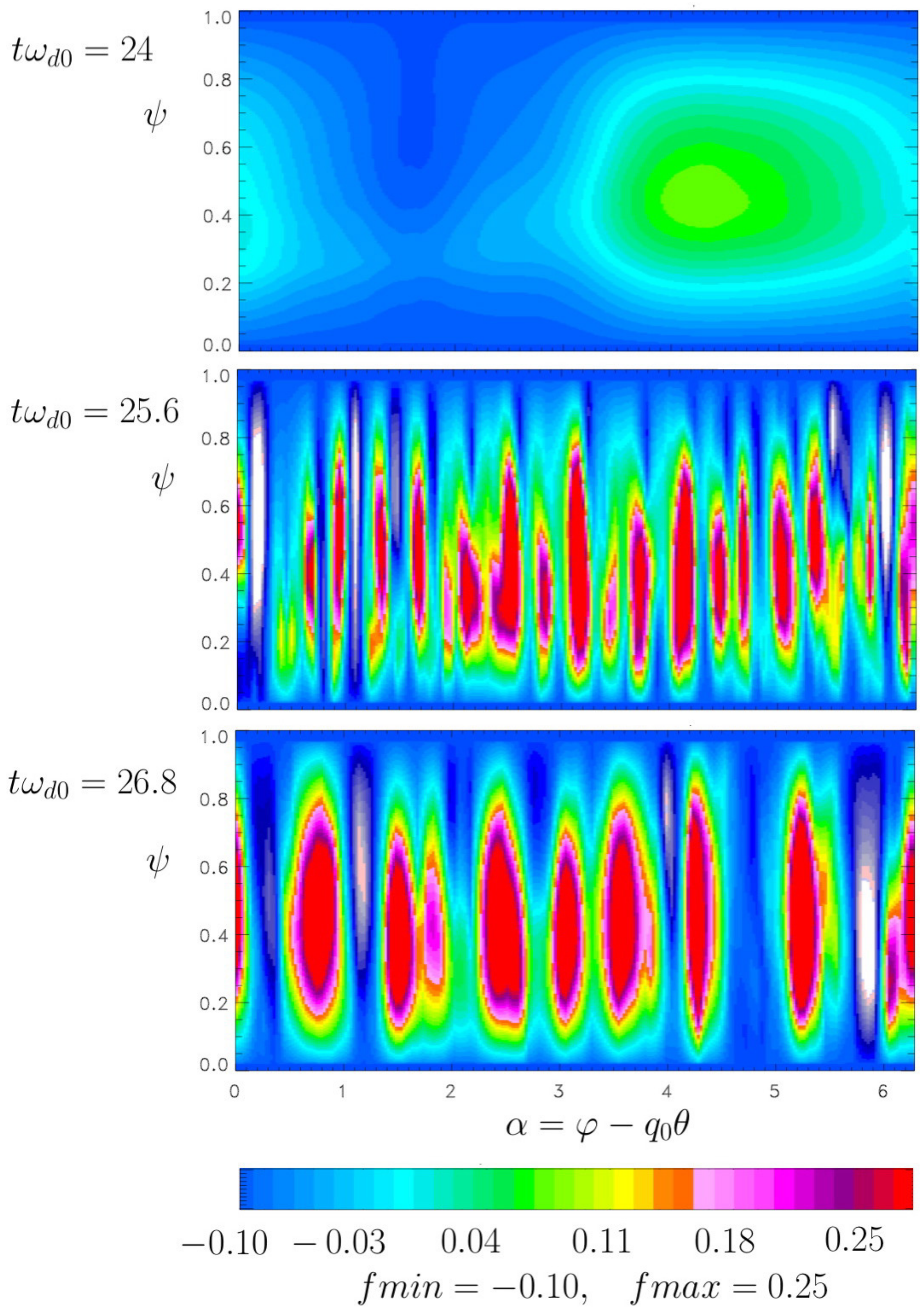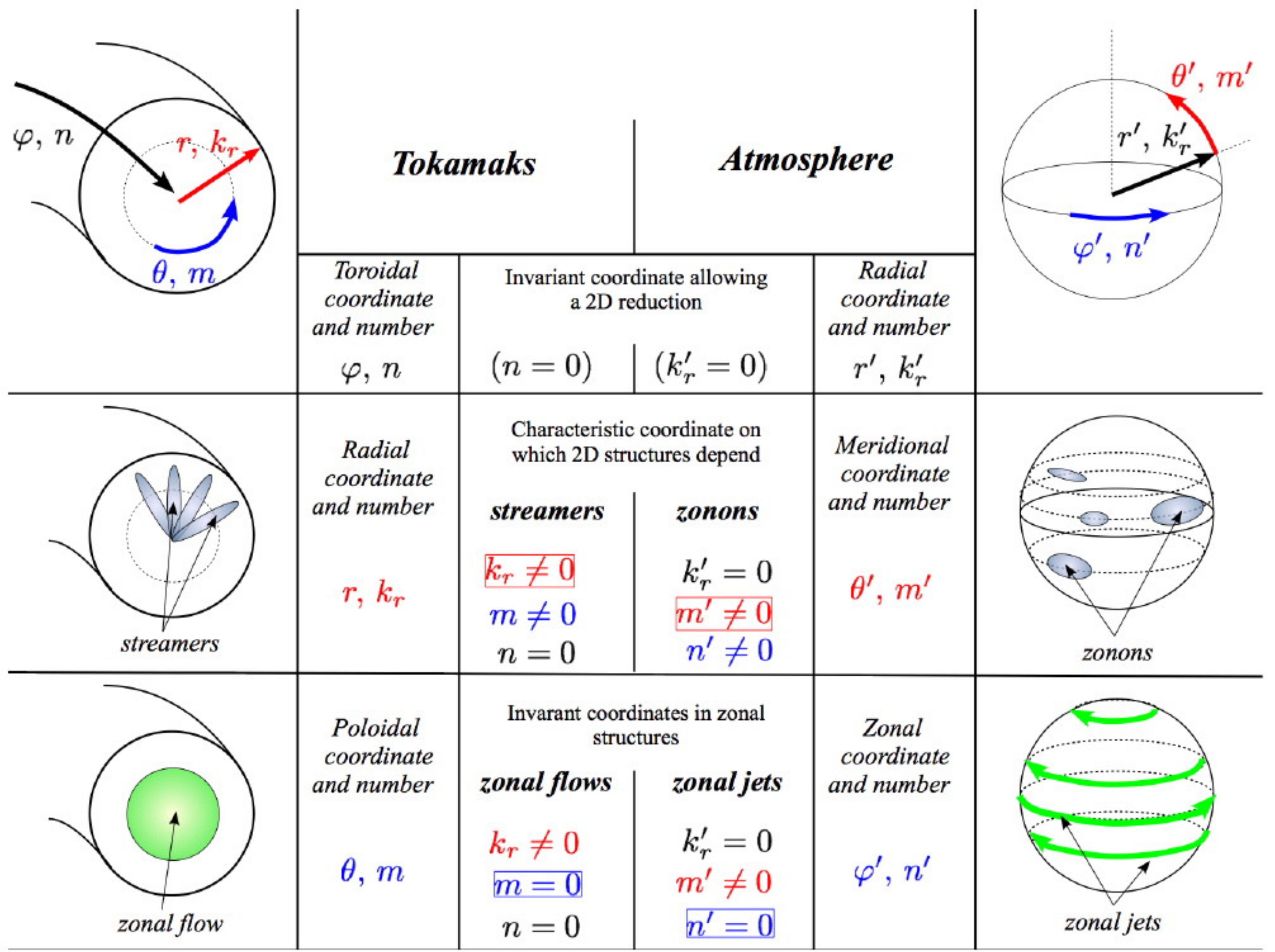1. Introduction
Understanding and controlling turbulence is one of the key elements for a successful magnetic confinement of a tokamak plasma. Turbulence due to drift-wave is a ubiquitous feature of magnetically confined plasmas. In the studies of magnetized plasmas, theories and simulations have predicted that drift-wave turbulence or interchange turbulence [
1], in the case of a toroidal geometry, can generate mesoscale structures, such as zonal flows (ZFs), sheared flows, but also streamers. These mesoscale structures, ZFs and streamers, have different behaviors and their impacts on turbulence-driven transport show strong contrasts. A spontaneous transition to a turbulence-suppressed regime is sometimes observed and is known as low-to-high (LH), confinement transition [
2]. Streamers appear to be closely associated with avalanche-type transport events and contribute to enhancing the transport owing to their radial elongated structures. Motivated by the experimental discovery of the LH transition, experiment and theory in the last decade have focused on whether the turbulence associated with the H-states might be regulated by interactions with ZFs. The generation of ZFs and their feedback on turbulence itself by shearing turbulent eddies and/or drift wave packets have been studied in Refs. [
3,
4,
5,
6].
The theoretical understanding of ZFs and streamers has first come from studies on the drift-wave model but also in the gyrokinetic turbulence modeling [
7], e.g., the ion temperature gradient (ITG) mode and the trapped ion modes (TIMs), thanks to the assumption of adiabatic invariance of the magnetic momentum and of the parallel kinetic energy of particles trapped in the so-called banana orbits [
8,
9], as well as gyro-fluid descriptions in a 2D or 3D space (see, e.g., Refs. [
10,
11]).
ITG modes are tokamak instabilities of interchange type (i.e., akin to the classical Rayleigh–Taylor instability in fluids), which determine the growth of perturbations in the poloidal angle because of charge separation effects due to an unfavorable radial variation of the so-called
-drift particle velocity (see
Figure 1). Since the latter is proportional to the particle kinetic energy component perpendicular to the local magnetic field, it depends on the particle temperature according to
where
T is the particle temperature in the poloidal plane,
e is the particle charge and
B is the amplitude of the magnetic field
. While in a tokamak the plasma temperature is radially decreasing outward from the core of the vessel, the magnetic field intensity
B, because of stability design, decreases in the direction opposite to the tokamak major radius (the intensity of the dominant toroidal magnetic field component being approximatively inversely proportional to the tokamak major radius
). As a consequence, the “outer” part of the poloidal section of the plasma with respect to the tokamak rotation axis has the gradients of both temperature and magnetic induction intensity pointing toward the axis. A perturbation in the poloidal angular direction will therefore mix the inner, warmer plasma, having a higher
-velocity, with the outer plasma, colder and then relatively slower. This difference in the angular velocity corresponds to a charge separation and to an angular electric field component, which will foster the mixing of the warm and cold portions of the plasma because of two oppositely oriented
-drift velocity components (
) along the radial direction.
A review of physics of ZFs can be found in Ref. [
12]. The generation of ZFs was also predicted in the geostrophic vortex equation by Charney in [
13] and by Hasegawa and Mima in Ref. [
14] in the case of drift-wave turbulence. This model aims to capture the essential physics while involving the least number of scalar fields as possible, in order to get a deeper physical insight and in the attempt to unravel the complexity of the phenomena under investigation. In this context, great interest has been recently attracted by the two-field descriptions (involving ion density and vorticity) provided by the Hasegawa–Wakatani [
15] (HW) and Modified Hasegawa–Wakatani [
16,
17] (MHW) models for drift-wave turbulence. They consist in a more complex formulation of the earlier and somehow simpler Charney–Hasegawa–Mima (CHM) model, successful in describing a wide variety of turbulent process, both in atmospheric fluids [
13] and in plasmas [
14]. On the other hand, barotropic instability is the atmosphere-ocean counterpart of plasma resistive drift-wave instability. In particular Charney in [
18] showed that the CHM model may describe the regime of geostrophic turbulence pertinent to the largest planetary scales. Even in its simplified barotropic version (with infinite Rossby deformation radius), the commingling of strong nonlinearity, strong anisotropy and Rossby waves give rise to complicated dynamics (see for instance Refs. [
19,
20]).
ZFs are also met in natural phenomena and the physics of ZF formation was also studied within the geophysical fluid dynamics community. Recently, in CHM flows with a small-scale forcing, the simulations have shown that the inherent anisotropy inverse energy cascade can lead to a new regime of turbulence, referred as the zonostrophic regime [
21], a particular regime of geostrophic turbulence as shown in [
22,
23]. This regime is characterized by an anisotropic spectrum, the formation of alternating zonal (east–west) jets and nonlinear (Rossby solitary) waves called zonons. These modes exhibit low frequency oscillations and display similarities with the resonant trapped-ion-mode (TIM) met in plasma physics. More recently, the data obtained from the Nasa spacecraft Cassini in Ref. [
24] have shown that Jupiter’s troposphere in sharp contrast to the Earth’s atmosphere, conforms to the regime of zonostrophic turbulence.
While considerable progress has been achieved in the understanding of the zonal flow physics, many aspects of the ZF dynamics remain nevertheless poorly understand. The generation of ZFs and their feedback to turbulence and transport are essentially nonlinear processes. ZFs are non resonant and are generated through the Reynolds tensor in the drift-wave turbulence. A clear indication of the key role played by ZFs was the recent observation in Ref. [
25] at the Experimental Advanced Superconducting Tokamak (EAST) or in the DIII-D tokamak in Ref. [
26], associated with a low frequency signal at a few kilohertz, i.e., at a much lower frequency than the usual geodesic acoustic mode, the geodesic version of ion acoustic modes. Central to all these physical turbulent systems, be they in the core region of the tokamak plasma or in the shallow rotating atmosphere, is the generation of ZFs, exhibiting low frequency oscillations, which are believed to be responsible for suppressing small-scale turbulence and stabilizing the turbulence. This brings us to an important question about the physical origin of these low-frequency oscillations while the ZF frequency is usually attributed to be zero in the hydrodynamic approach. From the work described in Ref. [
27], the answer appears to lie in the fact that the nature of the ZF is strongly modified by nonlinear effects induced by the resonant character of (kinetic) TIMs, at least for the case of turbulence met in tokamaks.
The kind of dynamics involved in all these systems has the same general structure, which explains the many qualitative similarities between the systems. In particular, in the case of the zonostrophic regime, the low frequency oscillations-referred as zonons- are interpreted as nonlinear perturbations which essentially depend on resonant triad interaction. This was theoretically predicted in Refs. [
21,
28] and can be recovered by a simple CHM model including a small-scale external driver. Even more surprisingly, the same general structure of the ZF, at least driven by the Reynold tensor, is found in the tokamak models of Hasegawa, Mima and Wakatani. As exemplified by the case of the study of zonostrophic turbulence, the possible occurrence of these nonlinear structures allows insight in the strong turbulence regime described by the CHM equation and in the role played by forcing term. However, although the reduced tokamak models of Mima, Hasegawa and Wakatani exhibit systematic deficiencies in representing the kinetic effects, since such effects are not included, accurate simulations of the ZF production require a correct representation of the resonant interaction energy transfer mechanism (in particular from small-scales).
In particular, the main interest in the HW and MHW models lays in their debated capability to account for a self-consistent generation of zonal flows by small-scale turbulence, and thus in the possibility to shed light in the spontaneous transition to a turbulence-suppressed regime. In this respect, these models display some differences.
While the feature of zonal-flow generation, driven by the Reynolds tensor, was already present in the fluid CHM framework, the CHM model seems to be inappropriate to describe the turbulence at small-scale without the introduction of an external forcing term. The HW model, which like the CHM model for plasmas evolves the ion vorticity (at the
-drift ordering) and the ion density fluctuations, was developed to describe anomalous edge transport induced by collisional drift-waves. It contains a term more than the CHM model. This term is due to the electron dynamics parallel to the magnetic field, as it is deduced from Ohm’s law, and linearly couples the fluid stream function, i.e., the electrostatic potential, with the ion density. Such parallel electron dynamics contribution enters with a coefficient, which is usually named the “adiabaticity parameter”, since it measures the electron adiabatic response along the magnetic field lines. The MHW differs from the HW model because the zonal components have been subtracted from such a linear coupling, and a further contribution proportional to the background inhomogenous density (assumed to be constant in time) times the drift velocity is included. These corrections to the HW model have been included in Ref. [
16] because it was mentioned that, without these terms, the original HW model was otherwise incapable of describing the zonal flow generation. This assertion, mentioned in Ref. [
17] to be at odds with the CHM limit of the HW model and with the fact that the CHM, was in turn capable of describing a self-consistent zonal flow generation, was pointed out by numerical simulations of the HW model to be true only for small values of the adiabaticity parameter [
17], for which both the MHW and HW models converge toward the 2D Navier–Stokes equation.
Thus, we need a reference model for generation of ZFs and their impact on the turbulence suppression that allows to characterize the nature of ZFs generated in the different reduced models such as CHM, HW and MHW. The Hamiltonian trapped ion model is a very useful and instructive model, even if restricted to plasma physics. The results from the reduced Hasegawa, Mima and Wakatani models also have to be regarded with some caution because the nature of ZFs depends on the effects at play in each model. A particularly insightful way to utilize and compare these reduced models is to examine the interactions of the drift-wave (or interchange-type ) turbulence with ZFs, by starting from the global trapped ion model.
In this paper, we address these points by providing a rigorous derivation of a MHW-type model from a reduced kinetic model for trapped ions in banana orbits, apt to describe the production of ZF through a resonant energy transfer mechanism [
1,
8,
9]. The trapped ion model can be seen as an extension of the HW model, and allows the description of TIMs, a prototype of collective modes of kinetic nature. This model allows a fine description of the interchange turbulence in which the resonant interaction between TIM and trapped ions takes place through the precession motion of the latter. In revising the hierarchy of CHM, HW and then MHW models, we will address how this hierarchy is linked to a closure condition obtained from the kinetic model, which allows us to recover the Reynolds tensor shear effects only in the HW approach, a mechanism that may impact the turbulence.
The MHW-type model differs however from the one proposed in Ref. [
16], to which it will be compared together with the HW model of Ref. [
17]. We then discuss the physical limits in which the kinetic equations reduce to the HW and CHM model, and we finally discuss some properties of the MHW set we have described. In particular, we present numerical results obtained from integration of the reduced kinetic, Hamiltonian gyrokinetic model for the trapped particles [
9] based on an action-angle model first discussed in Ref. [
8], which corresponds to a simplified version of the upgraded version called “TERESA”, by referring to one of its numerical parallel hybrid (OpenMI—Message passing Interface) implementations [
29] to describe the process of the ZF formation.
2. Hamiltonian Model for Ion Temperature Gradient (ITG) Turbulence
The model, we consider for a tokamak plasma, describes the dynamics of TIMs in which the gradient of temperature gives the source of free energy. TIMs play a major role in the range of frequencies that is well below the parallel transit frequency. TIMs are then obtained by averaging the particle dynamics over fast scales, that is, over the cyclotron and bounce motions in the toroidal geometry. This task is made easier in the framework of the Hamiltonian–Jacobi formalism using action-angle variables. Due to their curvature drift, the orbits of trapped ions in a tokamak display a “banana” shape centered on the low magnetic field side. The low-frequency response for TIM is obtained by making a phase-angle average over the cyclotron phase and the bounce motion. This is allowed by the invariance of the total energy
and of the so-called adiabatic invariant
, which is appropriate at the time scales of interest for this problem. Here, the label
G is a conventional notation which refers to the guiding centre and
refers to
polar coordinates. In agreement with the experimental conditions, we consider low
values and a poloidal field
lower than the toroidal magnetic field
. The modulus of the magnetic field is given by
where
is the minimal value of the magnetic field amplitude
B at
(
being then the major radius and
the minor radius). In this configuration, the action-angle coordinates of the trapped particle distribution are the precession angle
and the poloidal flux
. The poloidal flux is related to the poloidal field by
and
, where
q is the safety factor and
is the inverse aspect ratio. The precession angle is related to the toroidal and poloidal angle coordinates by
. The gyro-average operator
is approximated by Pade’s relation (see Refs. [
30,
31]):
This operator introduces a “banana” scale
corresponding to the width of the particle’s trajectory in the
direction, while the gyro-phase average on the Larmor radius
acts along the direction of the precession angle
. Rather than working with the adiabatic invariant
, it is interesting to introduce the pitch angle parameter
defined by the relation
where
. The use of the pitch angle
, rather than
, will allow us to characterize ions in the form of trapped populations (
) or of passing particles (
). Following the work of Kadomtsev and Pogutse [
32], the bounce and precession frequencies are respectively given by the following relations:
where
is the magnetic shear.
and
are the complete elliptic integral of the first and second kind, respectively. Trapped ions in a banana orbit are described by two invariants, the energy
E and the pitch-angle
, and by the distribution function
fulfills the Vlasov equation:
with the advective-term depending on the gyro-average operator
defined in Lable (
1) and expressed by means of the Poisson brackets
. The right-hand-side (RHS) expresses numerical particle diffusion (see the end of the section). The polarization effects have been taken into account in the quasi-neutrality equation by the introduction of the polarization density (the Laplacian term). This is due to the difference between the real trapped particle density and the bounce-averaged banana centre density. Assuming an adiabatic response for electrons, the quasi-neutrality condition
, where
and
are the fluctuations of the particle densities, reads:
Here,
is the equilibrium density, equal for both ions and electrons. The operator
, which describes polarization effects, introduces the spatial scales
and
. The first term on the left-hand side of Equation (
5) comes from the adiabatic condition of electrons while the second term is due to the polarization charge. The gyro-averaged ion density
is obtained by replacing the distribution
with
in the expression of the ion density,
, defined by
and
are constants accounting for
, the fraction of trapped particles, and for the ratio
of ion to electron temperatures,
and
. Trapped ion turbulence develops on a length scale of the order of the banana width
and on a time scale determined by
, where
. Here,
is constant since we have neglected the dependence in
and is found to be close to
. In Equation (
4), the diffusion coefficient
is introduced for numerical purposes. In practice, in the numerical code, this diffusion coefficient is set to zero everywhere, except in a small buffer region located on the boundaries of the numerical box at
and
. This choice allows to control the level of turbulence on the box boundaries (the buffer regions occupies less than 10% of the radial domain, in which a small diffusion process is applied with a constant coefficient
). In what follows, we will focus on the domain of interest, namely the core turbulent region where
D is zero.
It is interesting to recall here some general properties of the linear analysis of TIMs. By linearizing Equations (
4) and (
5), for an equilibrium distribution
given by Equation (
28) of
Section 5, one obtains, by considering a standard potential perturbation mode in the form
, the following relation:
with the usual Landau prescription on the imaginary part of
. Note that, in Equation (
7), we have neglected the polarization term in first approximation. As first noted in Ref. [
33], a convergence of the expansion for the pole’s calculation in Label (
7) can be obtained by considering a development around
leading to an estimation of the collisionless TIM frequency in the form (with
):
where we have taken the average over the
and
E variables. Here,
is the electron diamagnetic frequency,
is the wave vector (for the variable
) and
is the ion Larmor radius. Thus, it is possible to excite an oscillating ZF component when the last term in (
8) becomes of order of
. We then have
In Equation (
9), the resonant amplification is produced by a three-wave process in which an interchange mode (of frequency
and of toroidal number
n) decays into a resonant collisionless TIM (of frequency
and of toroidal number
n) and a ZF (with a zero toroidal number).
3. Recall of Previous HW, MHW-Type and CHM Models for Drift-Wave Turbulence
In the following, we are going to show the connection between the Hamiltonian model of
Section 2 with HW- and MHW-type equations. Before deriving the specific form the latter takes in this framework, we recall the HW and MHW-type formulations which have been proposed in two previous works [
16,
17]. They consist of a two-field theory involving the ion vorticity
and the ion density fluctuation, which in our notation reads
, by assuming that
. In the coordinate system
and in the non-viscous regime we consider, the MHW formulation proposed by Numata et al. [
16] reads
where
,
and
is the adiabaticity parameter that depends on electron-ion collisions through the resistivity
, and on the toroidal wave-length component
related to the poloidal scale length by
,
being the maximum angle
. The main difference with respect to the HW modelling (In a three-dimensional system, the distinction between the HW and MHW models disappears and the “adiabaticity parameter” is not a constant, but rather an operator proportional to
. However, since we are interested here in the radial contribution of the turbulence and not in the high-frequency contribution induced by high-frequency geodesic adiabatic mode (GAM) in zonal flow (and usually triggered by circulating particles), a two-dimensional approach is sufficient. Here, we have introduced the term “low-frequency” zonal flow (LFZF) to discriminate between the quasi-zero zonal flow (due to the Reynolds tensor) and the high-frequency GAM.) lays in having taken out the averages over
, so that the quantities
and
express the potential and ion density fluctuations, respectively. The parameter
is the normalized gradient of the density equilibrium profile,
. The particle flux in the
direction can be generated by out-of-phase fluctuations of
and
in
and depends on
itself, according to
This acts as a source term for the conservation of the energy
E of this MHW model (label
in the time derivatives below),
and of the enstrophy
,
The unmodified HW set of equations, which has been considered by Pushkarev in Ref. [
17], consists instead of the equations
Differently from Equations (
10) and (
11), besides the absence of the last term on the right-hand-side (RHS) of the density equation, the coupling term does not depend on averages over the
-coordinate. Labeling with “
”, the time derivatives of the energy and enstrophy in this unmodified HW model, they obey
5. Numerical Simulations
In this section, we discuss the results of numerical simulations performed in order to elucidate some of the key features of the interchange turbulence in the presence of TIMs.
Our numerical scheme is based on the integration of Equations (
4) and (
5) in a self-consistent way. The numerical algorithm is based on a semi-lagrangian scheme detailed in Ref. [
14], allowing the integration of the distribution function directly in phase space. It is worth noting that a semi-Lagrangian scheme was also applied in [
35] to improve the efficiency of numerical models of the atmosphere. Such a numerical scheme allows an accurate integration of the Vlasov equation along its characteristics. The code employs a classic time splitting scheme to separate the treatment of the advection due to the drift-frequency
but uses a full 2D advection in space to treat the advection due to the electric potential. It must be pointed out that semi-Lagrangian Vlasov simulations are slowly introduced in place of the well-known Lagrangian particle-in-cell simulations for two main reasons: the lack of numerical noise (in the sense that, in the Eulerian approach, the graininess parameter
tends to zero and where
is the Debye length and
the particle density) and the very good resolution of the distribution function in phase space provided the dimension of the momentum space is as lowest as possible (depending on the computational constraints).
We focus on the nonlinear generation of ZFs by varying the parameter
related to polarization effects. Equations (
4) and (
5) have been solved using a backward semi-Lagrangian scheme [
36]. Semi-Lagrangian Vlasov simulations have identified two different kinds of ZFs of somewhat different nature, the first kind of ZFs driven by the Reynolds tensor, as expected, in agreement with the results of the standard fluid HW model. The second type of ZFs is characterized by the resonant coupling with TIMs, a physical process that is not taken into account in the reduced HW model.
In numerical simulations, quantities are normalized as follows: the time is normalized to the inverse drift frequency
, the poloidal flux
is given in
units (with
), the energy
E is normalized to
. The electric potential is expressed in
units and the constants
and
introduced in the quasi-neutrality Equation (
5) are given by the relations
and
. The bounce and drift frequencies
and
depend explicitly on the pitch angle parameter
(and of course on the energy
E) and are given by Equations (
2) and (
3). The initial distribution function is given by:
In Equation (
28) the quantity
denotes the initial flow corresponding to the interchange case. Here,
is the normalized ion temperature gradient. The starting point for an investigation of interchange turbulence is the reduced gyrokinetic Vlasov Equation (
4) coupled with the quasi-neutrality equation condition (
5) initiated in an equilibrium state with a perturbation term of type:
The reason for introducing the
factor in Equation (
29) on the right-hand side instead of the standard potential perturbation in
is that this function is the marginal solution obtained in the linear analysis of the TIMs. Here, we choose a perturbation on the potential
.
Without dissipation, three energetic subsystems interact to produce the complexity observed in the interchange-type turbulence: the kinetic energy of the plasma
the energy of the zonal flow noted here by
and the potential fluctuation of turbulence
The energy components defined in Equations (
30)–(
32) verify the conservation law
Here, we have studied in detail the effects of the polarization term. A series of simulations has been performed for different values of the parameter
the other physical and numerical parameters being kept constant. In all simulations presented below, we have taken an ion temperature gradient of
, chosen above the threshold of the ITG instability given by
, for
and a banana width of
. We choose a Larmor radius of
and a magnetic shear of
, well inside the region of strong ITG instability. The phase space sampling is given by
and
points and we have used
values in pitch-angle and energy. The time step is
. The time evolution of the different energies is plotted for
in
Figure 2, in correspondence with non-negligible values of the electric potential.
We choose to start with a small value of
, i.e., well inside the Reynolds’ tensor-dominated regime. Results are presented, in the top panel of
Figure 2, the time evolution of the zonal flow energy
(in red and in solid line) together with its turbulent energy counterpart
(in blue and in dotted line). As shown in
Figure 2, the dynamics of the plasma are first governed by the growth of turbulence, as a result of the ITG instability. Here, it is the gradient in temperature that constitutes the energy source for the growth of TIMs, when the temperature gradient exceeds a critical value of
. The case of an initial density gradient and of a resulting shear flow generated by a Kelvin–Helmholtz instability was presented in Ref. [
37]. Here, the instability linked to a density gradient is not excited in the linear phase of ITG, but can appear later when nonlinear effects take place leading to the generation of shear flows. Note that at the saturation of ZF, in top panel in
Figure 2, the turbulent component of the energy has strongly decreased. In the bottom panel in
Figure 2, the corresponding evolution of the zonal flow component
, taken at
(in
unit), is plotted in a logarithmic scale. Aside from the fast oscillation in the linear phase (linked to the linear TIM), no oscillatory behavior is observed in the saturation regime, a signature of the role played by the Reynolds tensor in the fluid regime.
We will now address how ZF is modified in the kinetic regime by its coupling with TIMs leading to a low-frequency oscillatory behavior, a mechanism that is different from the standard Reynolds stress met in hydrodynamics, and which is not taken into account neither in the HW model, nor in the MHW model. A second simulation is performed with
. Results are shown in
Figure 3 to be compared to those used in
Figure 2. There is a qualitative change in the interchange turbulence, which now exhibits low-frequency oscillations just before the resonant amplification of the ZF component.
Zero-frequency ZF is quite non resonant and it is relatively easy for the Reynolds tensor to drive it up in a nonlinear way. While ZFs back-react upon turbulence by shearing, so weakening the source of their generation, it was shown in Ref. [
37] that Kelvin-Helmholtz (KH) instability may act as a damping mechanism for ZFs. However, this latter mechanism becomes inefficient when the nature of ZF is modified leading to a time-varying ZF, which becomes now sensitive to resonant amplification through parametric three-wave scattering. Thus, a transition from the fluid regime to a kinetic one for ZF is expected when the polarization increases. Here, the LFZF generation is a nonlinear process in which shorter-scale fluctuations transfer their energy to larger-scale potential structures. In addition to the first phase of growth of TIM turbulence (
), the nonlinear interaction leads to the growth of an oscillating mode on a frequency close to the drift frequency
.
Such a behavior can be observed in the intermittent regime of turbulence and is usually associated with a turbulence burst. In order to illustrate the rich nonlinear dynamics that underlie the resonant amplification of ZF, we have performed a new numerical simulation over a long time, for the same value of the polarization parameter
, but by diminishing the initial perturbation level of the potential by a factor ten, in order to follow the time evolution of the system in the (strong) intermittent regime of turbulence. This time, the time step is smaller,
the phase space sampling is
(here, we have reduced the sampling in
to
) and we have used
values in pitch-angle and energy. Numerical results are presented in
Figure 4,
Figure 5,
Figure 6 and
Figure 7. On the top panel in
Figure 4, we have plotted the temporal evolution of the energies of the zonal flow component
(in red and in solid line) and of the turbulent component
(in blue and in dotted line). The zonal flow energy displays three different stages during its evolution: a first phase characterized by a weak growth-rate for
, followed by a first resonant peak at
and finally a second resonant process, now located at time
, leading to a slow reduction of the turbulence after this time. On bottom panel in
Figure 4, the temporal evolution of the mean potential is represented in a logarithmic scale: we see clearly the emergence of different behaviors during the time evolution. While the beginning of the simulation is characterized by high-frequency oscillations (due to TIMs), followed by the bursting behavior at a lower frequency, the oscillatory behavior disappears, at saturation, indicating that a fluid-type regime is now recovered and dominated by the Reynolds tensor.
Figure 5 shows the spectrum in frequency of the electric potential for the considered numerical simulation (over the total time and at a fixed point
): we observe clearly both components of ZF, the quasi-zero part driven by the Reynolds tensor and the oscillating component , at a frequency close to
, a somewhat higher value than the predicted value of
(using a magnetic shear of
). It must be pointed out that the resonance takes place for the dominant streamer mode, i.e.,
. Indeed, both mode
and its harmonics
are excited, as can be seen in
Figure 5, where we have plotted the electric potential. This feature resembles the excitation of the nonlinear zonon mode, usually triggered by the same zonal wave vector of Rossby–Haurwitz waves (RHWs). In
Figure 5, we observe also the growth of the mode
and of its harmonics
. In the linear regime, the frequency of TIM is reduced to a value of
. However, TIM can propagate in the direction of the precession motion of ions allowing strong resonance with precessing ions: therefore, a slow decrease of TIM frequency is also possible when nonlinear trapping effects are important. Such a process has been already predicted by Morales and O’Neil in [
38]. Thus, due to strong nonlinear effects, the frequency of the kinetic mode
, initially close to the (linear) value
can slowly decrease to reach a value close to
, which finally leads to an estimation, for the ZF frequency, of
. It is this way that harmonics of ZFs can be excited.
Figure 6 shows the behavior of the electric potential at three different times when the resonance takes place, showing clearly that, in the asymptotic regime, the dominant modes are
and
. We have therefore identified a nonlinear coupling of ZF mediated by nonlinear collisionless TIMs, leading to a strong reduction of the interchange turbulence.
In
Figure 7, we have represented the mean ion pressure
, as a function of the poloidal flux
, and the corresponding electric potential at two times: the formation of a transport-barrier region (located around
, where the temperature gradient becomes negligible, is made evident. This also indicated that the ITG instabilities are now strongly reduced in this region. Here, it is the polarization source that triggers the barrier and reduces the level of turbulence (see Ref. [
39] for more details).
The last example, shown in
Figure 8,
Figure 9 and
Figure 10, describes the dynamics of the resonant mechanism in an accurate way, when we increase the polarization parameter to a value of
, i.e., well inside the kinetic regime of ZF. The numerical simulation was carried out using the same physical and numerical parameters of
Figure 2 and
Figure 3. We now focus on the transition toward the kinetic regime of ZF, which is triggered by the resonance of TIM wave with precessional trapped ions. An intermittent regime is observed (as expected in the dynamics previously shown in
Figure 4) and we focus here on the dynamics just before the occurrence of the first burst, when the nature of the ZF is modified. On the bottom panel in
Figure 8, we have plotted the electric potential, in a logarithmic scale, as a function of time. The oscillating nature of the ZF is clearly visible, even at saturation. In this saturation phase, ZF manifests as linear TIMs with a frequency
and no frequency shift. The turbulent energy density peaks at the small
n modes. These modes harbor the most energetic TIMs in the system. This mechanism is analyzed in more details through the phase space diagnostics shown in
Figure 9 and the spectra in wave-numbers (i.e., in toroidal numbers) are plotted in
Figure 10.
Figure 9 illustrates the details of the electric potential, when the resonance takes place: we observe clearly the formation of streamers (i.e., nonlinear structures elongated along the
direction). The intermittence is characterized by the generation of a turbulence burst at time
, as the result of the emergence of the resonant TIM with toroidal number
(note that the initial perturbed mode
has disappeared at that time). Diagrams in
Figure 10 reveal the occurrence of (nonlinear) streamers with a broad spectrum (with a toroidal number of
n∼ 16–24), as can be seen in the plot shown at time
. At time
, an inverse cascade takes place leading to a dominant mode on the toroidal number
, as indicated in the bottom panel in
Figure 9.
6. Connections with the Zonostrophic Turbulence in Geophysical Fluid
Dynamics
It is well known that the CHM equation and the quasi-geostrophic equation have the same structure. This makes it possible to establish a direct link between drift-wave turbulence in magnetically confined plasmas and the quasi-geostrophic turbulence in geophysical fluid dynamics (GFD). Both systems are approximately two-dimensional respectively because of the strong guide field applied to a magnetized plasma and because of the fast planetary rotation and strong density stratification in the quasi-geostrophic limit. Curiously, the same symbol
is used, although with completely different meanings, to characterize both the strong-guide field limit in a plasma and the regimes of quasi-geostrophic turbulence. As already recalled in the introduction, in a plasma,
labels the ratio between the kinetic and magnetic pressure, and it is small in the strong guide field approximation. In a tokamak, for example, for which an approximated two-dimensional description for the poloidal dynamics is allowed by the strong toroidal (guide) magnetic field, typically
. On the other hand, in geostrophic turbulence
denotes the ratio
where
and
R are the angular velocity and the radius of a rotating fluid spherical shell. As mentioned earlier in the introduction indeed, computer simulations of 2D barotropic turbulence on a
-plane surface of a rotating sphere gave rise to a classification of flow regimes, which become possible in these geostrophic systems, depending on the value of
. One of these is the regime of zonostrophic turbulence, which is characterized by an anisotropic inverse cascade and by slowly varying structures of strong alternating zonal jets. The barotropic vorticity equation (on the surface of such rotating sphere) is then given by
where
is the vorticity,
is the stream function with
,
is the Coriolis parameter (the planetary vorticity),
is the latitude and
the longitude. In (
34), the Jacobian
J is defined by
.
is the hyper-viscosity coefficient and
p the power of the hyper-viscous operator (
is usually used) and
is the linear friction coefficient that expresses the large-scale friction. In Ref. [
22], the authors have considered, in the CHM model, a small-scale forcing term
S that pumps energy into the system at a constant rate and that leads to a new regime of the geostrophic turbulence, the so-called zonostrophic regime. However, no justification on the origin of such source term in the forced CHM model was given. The development of this new regime of turbulence is characterized by the existence of a new class of nonlinear waves dubbled zonons.
Indeed, Equation (
34) can be solved using the decomposition of the stream function in spherical harmonics
, leading to a class of linear Rossby–Haurwitz waves (RHWs) of frequency given by
Fixing the reference unit of length so that
eliminates the difference between the indices of the spherical harmonics and wave numbers. The decomposition takes the usual form
where
and
are the meridional and zonal wave numbers, respectively (and
N a truncation index). It must be pointed out that we have kept here the notation
for the standard toroidal and poloidal numbers, respectively, and that the roles of
and
are inverted to tokamak’s with respect to toroidal geometry since
refers to zonal jet while
represents ZF in magnetically confined plasmas.
We recall indeed that, in the 2D description of drift-kinetic turbulence in a tokamak, the restriction to a planar geometry corresponds to the
condition, which holds for both zonal flows and streamers. In the 2D description of zonostrophic turbulence the restriction to a 2D geometry is given instead by the condition
. The correspondence between the
set of
toroidal coordinates in drift-kinetic turbulence in tokamaks and the
set of
spherical coordinates in zonostrophic turbulence in the atmosphere, also with respect to the zonal and nonlinear structures encountered in the two frameworks, is summarized in the scheme of
Figure 11.
The situation observed in the zonostrophic regime resembles the situation met in previous sections where LFZF is generated (see
Table 1 in which we have summarized the different waves implicated in the turbulent processes). We can say that, while ZFs are met in both plasmas and in the atmosphere, streamers in poloidal plasma turbulence are the correspective of zonons in zonostrophic turbulence. Our investigation reveals that, in tokamak turbulence, it is the small-scale wave-particle interactions (or nonlinear streamers) that determine the resonance conditions of the residual LFZF. Thus, a key physical point is that this low-frequency ZF can be excited by resonant triad. Moreover, in Ref. [
28], the authors have proposed that RHWs can produce ZF through an energy transfer mechanism, triggered by resonant triads. Thus, the turbulence is here dominated by waves that are involved in triad interaction. What is more interesting is that, in the zonostrophy turbulence, the zonon frequency
is equal to the frequency of the most energetic RHWs (by fixing a value of
) that excite zonons, as shown in Refs. [
21,
22,
23,
24,
28,
40,
41]. In particular,
is proportional to
, a feature which exhibits a similarity to the property of linear resonant kinetic (TIM) modes
(note that streamers are the nonlinear version of TIM) . Thus, the relationship between both types of waves is quite straightforward. Concerning the LFZF generation, there exists also, in the zonostrophic regime, zonal zonons with a frequency
whereas
for all values of the meridional wave numbers.
Finally, we would like to comment on the relation between the CHM equation given in (
19) and the trapped-ion model. Nonlinear small-scale effects are here introduced, in the right-hand-side member, which indeed disappears when taking the average over the
variable. This property shows that ZF is not affected by this term. It is not the case of the small-scale forced version of the CHM used in the study of the geostrophic turbulence: along with the linear RHWs, nonlinear small-scale structures (zonons) also emerge and an intense energy exchange between zonons and the ZFs can take place.

